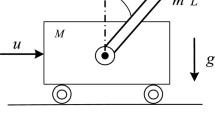Abstract
Conventional sliding mode control (SMC) has been extensively applied in controlling spacecrafts because of its appealing characteristics such as robustness and a simple design procedure. Several methods such as second-order sliding modes and discontinuous controllers are applied for the SMC implementation. However, the main problems of these methods are convergence and error tracking in a finite amount of time. This paper combines an improved dynamic sliding mode controller and model predictive controller for spacecrafts to solve the chattering phenomenon in traditional sliding mode control. To this aim, this paper develops dynamic sliding mode control for spacecraft’s applications to omit the chattering issue. The proposed approach shows robust attitude tracking by a set of reaction wheels and stabilizes the spacecraft subject to disturbances and uncertainties. The proposed method improves the performance of the SMC for spacecraft by avoiding chattering. A set of simulation results are provided that show the advantages and improvements of this approach (in some sense) compared to SMC approaches.














Similar content being viewed by others
References
Benenia, M., Batatia, H., Camino, F. M., & Benslama, M. (2013). Altitude control of a satellite using a feedback linearization. In IET conference on control and automation 2013: uniting problems and solutions (pp. 1–6). IET.
Shirobokov, M., Trofimov, S., & Ovchinnikov, M. (2021). Survey of machine learning techniques in spacecraft control design. Acta Astronautica, 186, 87–97.
Bayat, F., & Javaheri, M. (2020). Two-layer terminal sliding mode attitude control of satellites equipped with reaction wheels. Asian Journal of Control, 22(1), 388–397.
Crassidis, J. L., & Markley, F. L. (1996). Sliding mode control using modified Rodrigues parameters. Journal of Guidance, Control, and Dynamics, 19(6), 1381–1383.
Lo, S. C., & Chen, Y. P. (1995). Smooth sliding-mode control for spacecraft attitude tracking maneuvers. Journal of Guidance, Control, and Dynamics, 18(6), 1345–1349.
Xu, Y., Tatasch, A., & Fitz-Coy, N. (2005). Chattering free sliding mode control for a 6 DOF formation flying mission. In AIAA guidance, navigation, and control conference and exhibit (pp. 6464). AIAA.
Hui, L., & Li, J. (2009). Terminal sliding mode control for spacecraft formation flying. IEEE Transactions on Aerospace and Electronic Systems, 45(3), 835–846.
Jafari, M., Mobayen, S., Bayat, F., & Roth, H. (2023). A nonsingular terminal sliding algorithm for swing and stance control of a prosthetic leg robot. Applied Mathematical Modelling, 113, 13–29.
Mobayen, S., Bayat, F., & ud Din, S., & Vu, M. T. (2023). Barrier function-based adaptive nonsingular terminal sliding mode control technique for a class of disturbed nonlinear systems. ISA Transactions., 134, 481–496.
Wu, S. N., Sun, X. Y., Sun, Z. W., & Wu, X. D. (2010). Sliding-mode control for staring-mode spacecraft using a disturbance observer. Proceedings of the Institution of Mechanical Engineers, Part G: Journal of Aerospace Engineering, 224(2), 215–224.
Li, J., Pan, Y., & Kumar, K. D. (2012). Design of asymptotic second-order sliding mode control for satellite formation flying. Journal of Guidance, Control, and Dynamics, 35(1), 309–316.
Nair, R. R., Behera, L., Kumar, V., & Jamshidi, M. (2014). Multisatellite formation control for remote sensing applications using artificial potential field and adaptive fuzzy sliding mode control. IEEE Systems Journal, 9(2), 508–518.
Cao, L., Li, X., Chen, X., & Zhao, Y. (2014). Minimum sliding mode error feedback control for fault tolerant small satellite attitude control. Advances in Space Research, 53(2), 309–324.
Lee, K. W., & Singh, S. N. (2016). A higher-order sliding mode three-axis solar pressure satellite attitude control system. Journal of Aerospace Engineering, 29(1), 04015019.
Kang, J., Zhu, Z. H., Wang, W., Li, A., & Wang, C. (2017). Fractional order sliding mode control for tethered satellite deployment with disturbances. Advances in Space Research, 59(1), 263–273.
Wang, K., Hua, C., Chen, J., & Cai, M. (2020). Dual-loop integral sliding mode control for robust trajectory tracking of a quadrotor. International Journal of Systems Science, 51(2), 203–216.
Bayat, F. (2018). Model predictive sliding control for finite-time three-axis spacecraft attitude tracking. IEEE Transactions on Industrial Electronics, 66(10), 7986–7996.
Tantawi, K. H. (2007). Linear dynamic modeling of satellites with various flexible appendages. M.Sc. Thesis, University of Tennessee at Chattanooga.
Mohammadkhani, M. A., Bayat, F., & Jalali, A. A. (2014). Design of explicit model predictive control for constrained linear systems with disturbances. International Journal of Control, Automation and Systems, 12, 294–301.
Zanjani, M. S., & Mobayen, S. (2023). Event-triggered global sliding mode controller design for anti-sway control of offshore container cranes. Ocean Engineering, 268, 113472.
Hou, S., Wang, C., Chu, Y., & Fei, J. (2022). Neural-observer-based terminal sliding mode control: Design and application. IEEE Transactions on Fuzzy Systems, 30(11), 4800–4814.
Nguyen, Q. D., Nguyen, H. P., Vo, D. N., Nguyen, X. B., Ueno, S., & Huang, S. C. (2022). Robust sliding mode control-based a novel super-twisting disturbance observer and fixed-time state observer for slotless-self bearing motor system. IEEE Access, 10, 23980–23994.
Sindhuja, P. P., Panda, A., Velappan, V., & Panda, R. C. (2023). Disturbance-observer-based finite time sliding mode controller with unmatched uncertainties utilizing improved cubature Kalman filter. Transactions of the Institute of Measurement and Control, 45(9), 1795–1812.
Author information
Authors and Affiliations
Corresponding authors
Rights and permissions
Springer Nature or its licensor (e.g. a society or other partner) holds exclusive rights to this article under a publishing agreement with the author(s) or other rightsholder(s); author self-archiving of the accepted manuscript version of this article is solely governed by the terms of such publishing agreement and applicable law.
About this article
Cite this article
Nikyar, J., Bayat, F. & Mohammadkhani, M. Robust non-aggressive three-axis attitude control of spacecraft: dynamic sliding mode approach. Control Theory Technol. 21, 505–514 (2023). https://doi.org/10.1007/s11768-023-00176-5
Received:
Revised:
Accepted:
Published:
Issue Date:
DOI: https://doi.org/10.1007/s11768-023-00176-5



